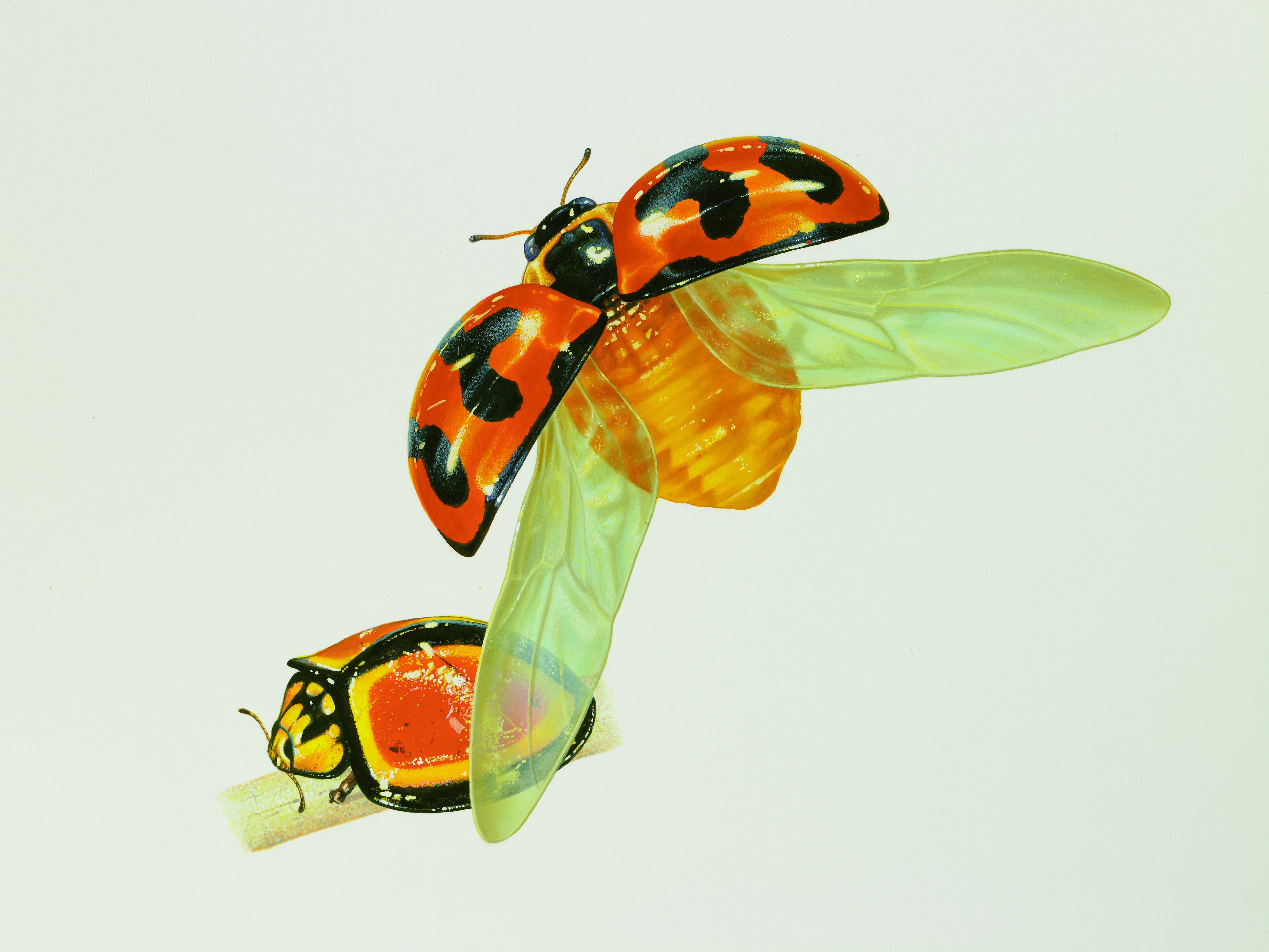Ladybirds, every child’s favourite bug

THE RICHLY VARIED patterns and colours of ladybirds are truly captivating, but it’s their voracious appetites that underscore their popularity with gardeners and farmers.
Australia hosts more than 500 ladybird species, most of which are predators of aphids and scales — insect pests that feed on plant sap and cause serious damage to gardens and crops when they occur in large numbers.
In 1888, the Australian native vedalia ladybird became the world’s first biocontrol agent when it was exported to California to rid citrus orchards of cottony-cushion scale. The mealybug ladybird followed in 1891 and successfully controlled California’s citrus mealy bug.
Today ladybirds such as the transverse, maculate and minute two-spotted species control aphid populations, and thus increase yields in the Australian cotton industry, one of our highest rural export earners. Ladybirds are rarely preyed upon: they taste terrible. They further repel predators by emitting a noxious liquid from their leg joints when threatened.
Spotted potato ladybird
Henasepilachna vigintiactopunctata
This herbivorous ladybird is a pest on crops such as potato, pumpkin and tomato. Its elytra (forewings) have black spots – 28 in total -and are covered in dense short hairs.
Found: All States and territories except SA, Victoria and Tasmania
Size: 7 mm
Food: Flowers and leaves of tomato, pumpkin, potato, cabbage and bean plants

28-spotted potato ladybird. (Image Credit: Ego Guiotto)
Mealybug ladybird
Cryptolaemus montrouzieri
Mealybug ladybird larvae and adults feed on the eggs and nymphs of common insect pests such as mealy bugs. Larvae are covered by whitish waxy secretions and resemble mealy bugs, but are about twice the size of the adult female citrus mealy bug.
Found: All States and territories except Tasmania
Size: 3-4 mm
Food: Mealy bugs

Mealybug ladybird. (Image Credit: Ego Guiotto)
Red chilocorus or armoured scale predator
Chilocorus circumdatus
Used as biocontrol agent on orchard crops. Adult females lay cylindrical eggs 1 mm beneath the cover of scale insects. Larvae are voracious feeders.
Found: NSW and Queensland; originally from India
Size: 4-5 mm
Food: Scale insects including white louse scale, oleander scale, oriental scale and red scale

Red chilocorus or armoured scale predator. (Image Credit: Ego Guiotto)
Spotted amber ladybird
Hippodamia variegate
Previously believed to be restricted to Europe, Russia and China but now widely distributed in Africa, North America and elsewhere. Discovered in the Lockyer Valley, Queensland, in November 2000. Eats up to 50 aphids a day.
Found: All States and territories
Size: 4 mm
Food: Aphids

Spotted amber ladybird. (Image Credit: Ego Guiotto)
Vedalia ladybird
Podolia cardinalis
The first biocontrol agent ever used, the vedalia was shipped to the USA in 1888 to control cottony-cushion scale insects in California citrus orchards.
Found: All States and territories except NT and Victoria
Size: 3-4 mm
Food: A few species of the genus lcerya

Vedalia ladybird. (Image Credit: Ego Guiotto)
Transverse ladybird
Coccinella transversalis
This is one of the most commonly encountered ladybirds in the gardens and parks of Australian cities.
Found: All States and territories in urban areas, forest, heath and woodland
Size: 4-6 mm
Food: Aphids
Australoneda burgeoisi
Little is known of the biology of A. burgeoisi, Australia’s largest ladybird.
Found: Queensland and northern NSW
Size: 8-11mm
Food: Probably feeds on aphids

The Traverse ladybird and the Australoneda burgeoisi. (Image Credit: Ego Guiotto)
Fungus—eating ladybird
Illeis galbula
Larvae are creamy white with lines of black dots on their backs and grow up to 8-10 mm.
Found: All States and territories except WA and Tasmania
Size: 3-5 mm
Food: Black mould found on leaves of various plants

Fungus—eating ladybird. (Image Credit: Ego Guiotto)
READ MORE:




